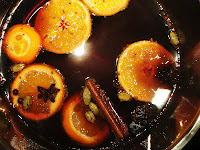QUINCE PASTE
My quince tree is laden with huge fruit so it's time to dig out the quince paste recipe. Even after three years of making it I still find it difficult to judge when it has cooked enough. I think I need to be more patient and leave it to dry for a month or so. It's difficult to do because it is so delicious I want to tuck into it straight away.
BASIC QUINCE PASTE
5 or 6 quinces
water
sugar.
Prepare a large bowl of water. Add juice of a lemon to prevent discolouration when you add the quartered fruit. Peel and core quinces. Cut the quinces into quarters and place in the water. Set aside.
Place the peel and the cores into a large pan, cover with water and simmer, uncovered for an hour. Strain, squeezing out as much liquid as possible.
Weigh the quince quarters and add to a large heavy bottomed pot. Add the strained liquid and bring to the boil. Simmer, uncovered, for about an hour, stirring occasionally. When the fruit is soft, place fruit and liquid in a food processor. Puree until smooth.
Return the pureed fruit to the pot and add sugar in a ratio of 3 of fruit to 2 of sugar. Eg, for 600g fruit, add 400g sugar. Simmer slowly for 3 - 5 hours until the paste changes to a dark rose colour and the bottom of the pot is visible when the paste is stirred. It must be very thick.
Pour into an greased tray. The tray size varies depending on the size of the fruit. I use an 18cm x 27cm tray. Leave it to cool overnight. It should be solid but still sticky. (If it isn't, either use it as jam or recook it until it will set.) Turn the slab out onto chux and wrap it up. Place it on a wire rack and keep it in a cool, dark place for a month. When the surface has dried out, the paste is ready to eat.
FLAVOUR IT UP.
I like to add the juice and peel of a lemon to the pot of cores and peel. I also love to add chopped ginger to the cooked quince mix.
Welcome to my kitchen. Living in the country means many of the exotic ingredients listed in the food magazines are simply not available. So all the ingredients I use are easily accessed, although I must admit, I buy some of my spices on-line. I look forward to sharing some of our family favourites with you.
Sunday, 29 April 2012
Saturday, 7 April 2012
GLUHWEIN
 I can feel winter creeping in. I have my bookclub in June so I'm making the most of the cold with a warm fire and serving Gluhwein as a winter warmer to start the night - and maybe even finish it. I first tried it in Vienna at one of the Christmas markets where every evening people stopped after work and huddled round patio umbrellas to shelter from the snow, sipping mugs of Gluhwein. I have a wine rack full of lovely Willow Bridge reds and as I'm not really a red wine drinker, I can't wait to make this concoction and see what my bookclub members think. I may try it out on my sisters first - if I can get them together at one time.
I can feel winter creeping in. I have my bookclub in June so I'm making the most of the cold with a warm fire and serving Gluhwein as a winter warmer to start the night - and maybe even finish it. I first tried it in Vienna at one of the Christmas markets where every evening people stopped after work and huddled round patio umbrellas to shelter from the snow, sipping mugs of Gluhwein. I have a wine rack full of lovely Willow Bridge reds and as I'm not really a red wine drinker, I can't wait to make this concoction and see what my bookclub members think. I may try it out on my sisters first - if I can get them together at one time. GLUHWEIN
To 2 bottles of good red wine you need to add:
- 1 cup Caster sugar
- 4 Cinnamon sticks
- Whole cloves - enough to stud the slices of orange
- 1 Oranges sliced
- 1 tsp allspice
- 1 cups of orange juice or a good splash of Grand Marnier, port, brandy or sherry. Some like to add the juice as well as the 'kicker/s'.
Method:
- Pour the red wine into a pot and put it on the stove on a very low heat but do not let the wine boil. Very important
- Cut the oranges into slices and then put about 4 cloves into each slice.
- Break the cinnamon sticks in half.
- Add in the orange juice or liquer, port, sherry etc, allspice, cinnamon sticks and oranges.
- Add in 1 cups of sugar and stir.
- Stir on and off for about 30 mins to give the spices time to infuse with the wine.
- Let it infuse over a very low heat for about 30 mins more but make sure it doesn't boil.
- Serve in ceramic wine pots or mugs.
Subscribe to:
Comments (Atom)
